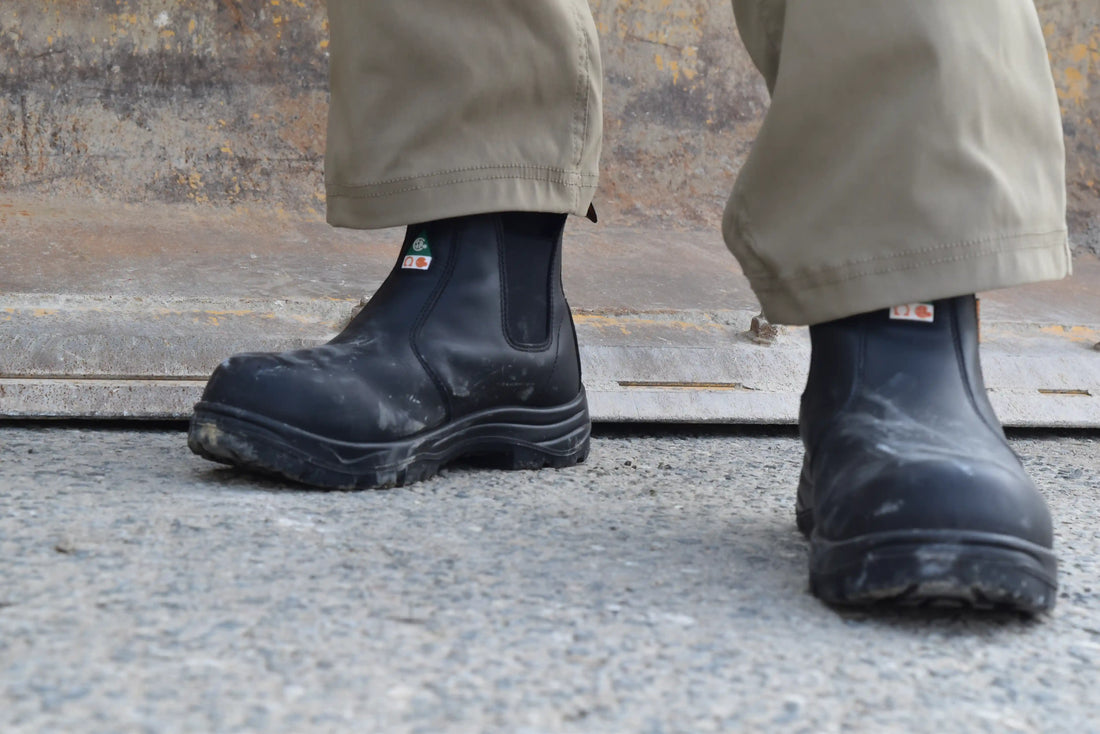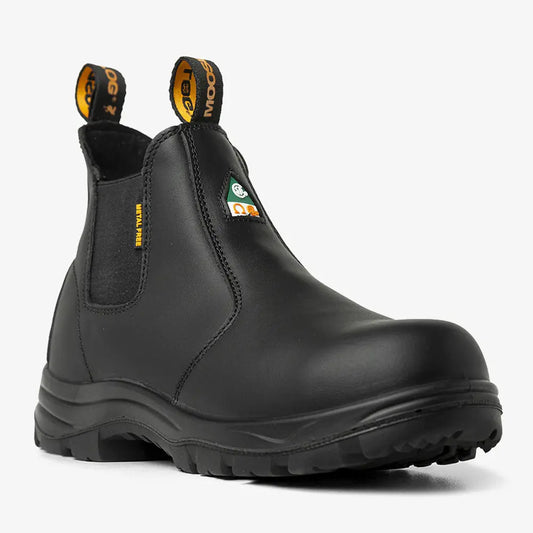
Inside a Safety Boot: Every Layer Explained
When it comes to workplace safety, footwear is one of the most important lines of defence. Whether you're on a construction site, in a warehouse, or working with heavy equipment, a pair of certified safety boots can help prevent serious injuries. But what exactly makes a boot “safe”? What’s going on inside those layers?
This guide takes you inside a modern safety boot and breaks down the core components that meet safety standards like CSA Z195 and ASTM F2413. If you’re required to wear safety footwear on the job, or simply want to understand what you’re standing on all day, this is what you need to know.
1. Outer Material – The First Barrier
The outer layer of a safety boot is typically made from leather, synthetic materials, or a combination of both. This material protects against abrasions, moisture, sparks, and other external hazards. In many boots, the leather is treated to be water-resistant or heat-resistant, depending on the intended work environment.
Key purposes:
- Shields the foot from environmental elements
- Maintains structural support
- Contributes to water or chemical resistance
2. Safety Toe Cap – Steel, Composite, or Alloy
The safety toe cap is the most recognizable feature of protective footwear. It’s designed to protect the toes from impact and compression injuries caused by falling objects, equipment, or materials.
There are three common types of safety toe caps:
- Steel toe: Traditional, extremely strong, and relatively inexpensive, but heavier and conductive (not ideal for electrical environments).
- Composite toe: Made from materials like fiberglass or carbon fiber. Non-metallic, lighter than steel, and does not conduct electricity.
- Alloy toe: Often made from aluminum or titanium. Lighter than steel, but thinner and more expensive.
To be certified, the toe cap must pass tests for:
- Impact resistance (I) – protection from falling objects
- Compression resistance (C) – protection from crushing forces
For a detailed comparison of toe cap types, see our blog post: Steel Toe vs Composite Toe vs Alloy Toe: What’s the Difference?
3. Internal Lining – Breathability and Comfort
Beneath the outer material, a moisture-wicking lining helps manage sweat, regulate temperature, and add comfort. Some linings are made with antimicrobial materials to reduce odour and bacteria buildup.
Higher-quality boots may also include seam-sealed membranes to improve water resistance without sacrificing breathability.
Purpose:
- Maintains comfort during long shifts
- Reduces blistering and skin irritation
- Helps manage moisture and internal temperature
4. Insole – Cushioning and Support
The insole, or footbed, sits directly under the foot and is responsible for shock absorption, arch support, and overall comfort. Insoles are typically made from PU (polyurethane) or EVA foam, and some may be removable or dual-layered for customization.
Features to look for:
- High rebound cushioning
- Arch support for long periods of standing
- Moisture-wicking fabric on the surface
A good insole reduces fatigue and helps prevent long-term foot issues like plantar fasciitis, especially in jobs that require long hours on hard surfaces.
5. Puncture Resistant Plate – Midsole Protection
Jobs that involve construction, demolition, or handling sharp objects require puncture-resistant footwear. A midsole plate, placed between the insole and the outsole, protects against penetration from nails, metal shards, glass, and other sharp hazards.
Two common materials:
- Steel plates: Highly durable, less flexible, and heavier
- Composite plates: Lightweight and flexible, often made from aramid fiber or similar materials
For certification, the boot must pass the PR (puncture resistant) rating under both CSA and ASTM testing protocols. Want to know more? Check out our guide: What Makes a Boot Puncture Resistant?
6. Midsole Layer – Shock Absorption and Flexibility
Separate from the puncture plate, many safety boots have a midsole cushioning layer that works to absorb shock and provide rebound. This layer supports the heel and arch, distributes pressure evenly, and helps reduce joint strain over long shifts.
It may be constructed from:
- PU (Polyurethane) – more durable and springy
- EVA (Ethylene-vinyl acetate) – softer, more flexible but wears out faster
The midsole’s role is critical in preventing fatigue and promoting better posture while working on uneven or hard surfaces.
7. Outsole – Traction and Slip Resistance
The outsole is the part of the boot that makes contact with the ground. It’s usually made of rubber or TPU (thermoplastic polyurethane) and must be designed to handle the conditions of the jobsite.
Key outsole properties:
- Slip resistance – tested on oily, wet, or smooth surfaces
- Oil and chemical resistance – common in industrial environments
- Heat resistance – often rated for up to 300°C
- Electrical hazard (EH) or electro-static dissipative (ESD) protection
Outsole patterns vary. Construction and outdoor workers benefit from deep-lug patterns, while warehouse and factory workers may need flatter, smoother treads for cleaner indoor surfaces.
8. Boot Construction – Cemented, Welted, or Direct Attach
How the sole is attached to the upper affects weight, flexibility, water resistance, and repairability.
- Cemented construction: Lightweight and flexible. The sole is glued to the upper. Most common and affordable.
- Goodyear welt: The upper and sole are stitched to a leather welt. More durable and repairable, but heavier.
- Direct attach: The sole is molded directly to the upper using heat and pressure. Offers strong bonding and water resistance.
Each construction method has trade-offs. Cemented boots are lighter and cheaper. Welted boots are heavier but last longer. Direct attach offers excellent sealing.
9. Fit and Foot Shape – The Overlooked Factor
No matter how well a boot is built, if it doesn’t fit properly, it’s a safety hazard in itself. A good safety boot should match the shape of your foot, offer room for toe movement, and secure the heel to prevent slipping.
Features that improve fit:
- Wide toe box
- Padded collar and tongue
- Multiple width options
- Break-in flexibility
Poorly fitting boots increase the risk of trips, foot pain, blisters, and even long-term musculoskeletal issues.
Final Thoughts: Know What You’re Wearing
Safety boots are engineered with purpose, layer after layer, based on decades of industry standards and workplace needs. From impact protection and puncture resistance to comfort and traction, every layer serves a role.
Before buying, check for:
- CSA Z195 or ASTM F2413 certification
- Proper toe protection for your industry
- Puncture resistance if you work around nails or scrap
- Electrical hazard protection where needed
- Slip-resistant outsoles suited to your work environment
Understanding what's inside your boots means making better choices for your safety, your comfort, and your career.
Every MooseLog boot is built with each layer carefully considered for comfort, tested for safety, and certified to meet CSA and ASTM standards. Explore MooseLog Safety Boots.






